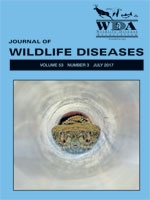Rabbit hemorrhagic disease virus (RHDV) was released in Australia as a biocontrol agent for wild European rabbits (Oryctolagus cuniculus) in 1995–96; however, its effects were variable across Australia with the greatest population reductions seen in lower annual rainfall areas (<400 mm). There is speculation that the reduced effectiveness observed at higher annual rainfall sites is at least partially due to the presence of a nonpathogenic calicivirus (RCV-A1). The RCV-A1 is related to RHDV and confers partial and transient protection against lethal RHDV infection in laboratory tests. What is not well understood is where, how, and to what degree RCV-A1 impedes the effect of RHDV-mediated rabbit control under field conditions. We investigated seven wild rabbit populations across six states and territories representing different seasonal rainfall zones across Australia, four times during 2011–12, to investigate if the presence and prevalence of RCV-A1 coincided with a change in RHDV immunity status within these populations. Besides serology, tissue samples from both trapped and shot rabbits were collected for virus detection by reverse transcription PCR. Overall, 52% (n=258) of the total samples (n=496) tested positive for RHDV antibodies and 42% (n=208) positive for RCV-A1 antibodies; 30% (n=150) of the sera contained antibodies to both viruses. The proportion of rabbits with RHDV antibodies increased significantly at sites where RCV-A1 antibodies were present (χ21, α=0.1, P<0.001). Evidence that preinfection of RCV-A1 may lead to a higher proportion of sampled rabbits with antibodies to both viruses was found at only one site.
BioOne.org will be down briefly for maintenance on 17 December 2024 between 18:00-22:00 Pacific Time US. We apologize for any inconvenience.
How to translate text using browser tools
1 July 2017
DIFFERENT SEROLOGICAL PROFILES TO CO-OCCURRING PATHOGENIC AND NONPATHOGENIC CALICIVIRUSES IN WILD EUROPEAN RABBITS (ORYCTOLAGUS CUNICULUS) ACROSS AUSTRALIA
Tarnya E. Cox,
June Liu,
Remy van de Ven,
Tanja Strive
ACCESS THE FULL ARTICLE

Journal of Wildlife Diseases
Vol. 53 • No. 3
July 2017
Vol. 53 • No. 3
July 2017
biocontrol
disease
epidemiology
introduced
resistance
RHDV
wildlife




